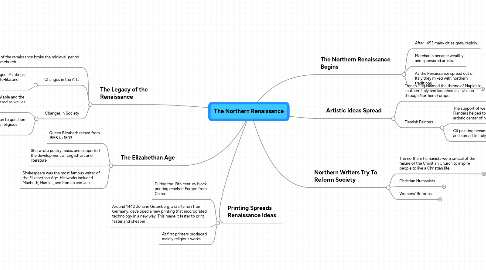
1. The Elizabethan Age
1.1. Queen Elizabeth reined from 1558 to 1603
1.2. She wrote poetry music and supported the development of English art and literature
1.3. Shakespeare was the most famous writer of the Elizabethan Age. His works included Macbeth, Hamlet, and Romen and Juliet.
2. Printing Spreads Renaissance Ideas
2.1. During the 13th century block printing reached Europe from China.
2.2. Around 1440 Johann Gutenberg, a craftsman from Germany, developed a new printing that incorporated technology in a new way. This made it faster to print faster and cheaper
2.3. At first printers produced mainly religious works
3. The Legacy of the Renaissance
3.1. The legacy of the renaissance broke the midieval-period focus on the church
3.2. Changes in the Arts
3.2.1. Techniques and styles changed. Paintings and sculptures were more life-like and realistic
3.3. Changes in Society
3.3.1. Books became more available and the desire for learning increased as well as literacy.
3.3.2. People began to question political and religious practices
4. The Northern Renaissance Begins
4.1. After 1453 many cities grew rapidly.
4.2. Merchants became wealthy and sponsored artists.
4.3. As the Renaissance spread out of Italy they mixed with northern traditions.
4.3.1. As a result the northern Renaissance developed its own character.
5. Artistic Ideas Spread
5.1. French king claimed the throne of Naples in southern Italy and launched an invasion through Northern Europe.
5.1.1. As the war dragged on many Italian artists and writers left for a safer life in Northern Europe.
5.1.1.1. The Italian artists brought styles and techniques of the Italian Renaissance.
5.2. Flemish Painters
5.2.1. The support of wealthy merchant families in Flanders helped to make Flanders the artistic center of northern Europe.
5.2.2. Oil painting became popular and spread to Italy.
6. Northern Writers Try To Reform Society
6.1. The northern humanists were critical of the failure of the Christian Church to inspire people to live a Christian life.
6.1.1. This criticism produced a new movement known to Christian humanism. The focus was the reform of society.
6.1.1.1. The humanists promoted the education of women and founded schools attended by boys and girls.
6.2. Christian Humanists
6.2.1. The best known Christian humanist was Erasmus. His most famous work, The Praise of Folly, this work poked fun at greedy merchants, heartsick lovers, quarrelsome scholars and pompous priests.
6.2.1.1. Erasmus believed in a Christianity of the heart, not ceremonies and rules. He thought that in order to improve society all people should study the bible.
6.3. Womens' Reforms
6.3.1. During this period the vast majority of Europeans were unable to read or write.
6.3.1.1. Those families who could afford formal schooling usually sent only their sons. Christine de Pizan was one of the first European writiers to question different treatment of boys and girls.
